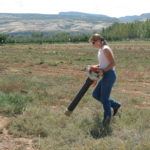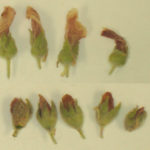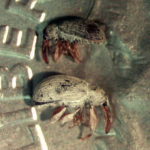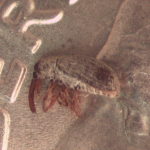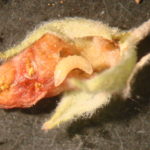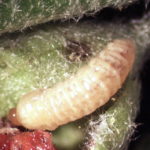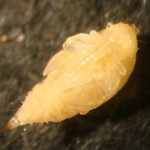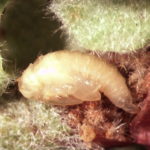The Sphaeralcea Weevil
A seed increase planting of scarlet globemallow, Sphaeralcea coccinea, near Hotchkiss, CO (Delta County) was found to be infested with seed feeding straight-snouted weevils (Apionidae). A suction sample was taken on May 11, 2007 while the field was in full bloom, and adult weevils were common. A plant sample was taken on May 21, and eggs, larvae, pupae and adult weevils were present. Twenty-five percent of the developing seed in the sample had been destroyed on that date. Globe mallow are indeterminate bloomers, and the weevils are feeding on developing seed pods while the plant is still producing new flowers. It appears that there will be multiple generations of the weevil and the damage potential is high.
Two species of weevils were present in the field. Anthonomus sphaeralciae Fall (Coleoptera: Apionidae) was the dominant species, with an unidentified Apion sp. (Coleoptera: Apionidae) also present.
Sphaeralcea weevils were also found in a planting of globe mallow in Montezuma Co. CO. Populations were much smaller that those observed in Delta Co. Weevils are probably widespread across western states where Sphaeralcea is native.
The first step in management is to monitor for their presence. Use a sweep net or suction sampler to sample for adult weevils. Inspect developing fruits for the presence of damage, larvae, and pupae.
If adult control is an option insecticides should be applied to prevent egg laying. If larvae are present, a systemic insecticide application may be an option. Any insecticide application should be carefully considered since they will be applied during bloom and precautions should be taken to protect pollinators. If you wish to discuss control options, please e-mail Bob Hammon.
| Petals of damaged flowers are wilted and shriveled. The damage will be apparent when the petals are pulled away from the calyx. Larvae may be present at this stage. Flowers in the top row are undamaged. A larva was found in each of the damaged flowers in the bottom row. | |
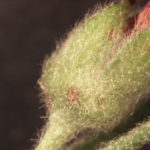 Photo by Melissa Franklin |
Egg laying scars are discolored spots that may be anywhere on the calyx. The female weevils probably chew a hole in which eggs are deposited. |
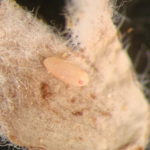 Photo by Melissa Franklin |
Eggs are laid between the calyx and ovary. They are creamy white in color and about 0.9 mm in length. They have a series of raised ridges running the length of the egg. |
| Adult weevils are grayish in color. They have a long snout that projects forward when they are alive. There were two distinct sizes in our collection. I don’t know the significance of the size differences yet. These are sitting on a dime for scale. Adults are easily found using a sweep net. | |
| Larvae are 4-5 mm long, with distinct head capsule and no true legs. This picture was taken from above, the head capsule cannot be seen. They are creamy white in color.They feed externally on the ovaries, between the calyx and developing seed pods. | |
| This picture shows the head capsule. | |
| You can see the legs, snout and developing wings in the pupa. It is found within a damaged flower, at the same site as the larval feeding. | |
| The pupa is very active when disturbed. |


